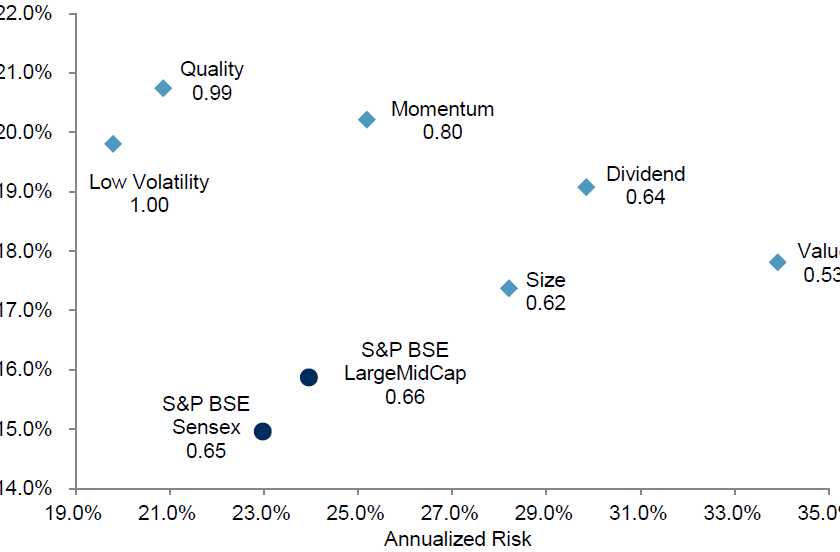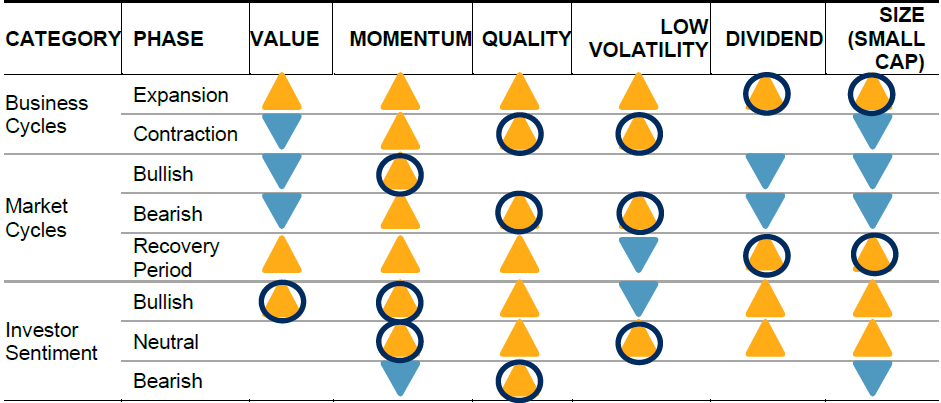ViniyogIndia Multifactor Portfolio is based on a multifactor Regime Switching model where factor exposures are controlled by Market Regime forecasts. Suitable for moderately aggressive investors.
ViniyogIndia offers model portfolios based on Quantitative Factor Investing strategy. Factors are quantitative attributes that can be used to explain asset returns.
Mathematically, if we try to model Asset Pricing behavior as a liner multivariate function, then factors represent the independent or explanatory variables of the function.
Factor strategies have been extensively researched globally as well as in India. The below chart for example, summarizes the risk-return characteristics of single-factor portfolios in India between October 2005 and June 2017. Over the period, all major single-factor portfolios outperformed the S&P LargeMidCap.
ViniyogIndia’s factor portfolios use a combination of factors that are proven to work well in the Indian markets.

Source: S&P Dow Jones Indices LLC. Data from October 2005 to June 2017. Index performance based on total return in INR. Past performance is no guarantee of future results
Portfolio Design Rules
Macroeconomic and market events affected each factor in different ways. Below chart summarizes performance characteristics of factors in different macroeconomic regimes, including market cycles, business cycles, and investor sentiment regimes in India

Source: S&P Dow Jones Indices LLC. Data from October 2005 to June 2017. Index performance based on total return in INR. Note: Yellow, upward triangles represent favorable performance (positive excess return with outperformance probability not lower than 50%), while blue, downward triangles represent unfavorable performance (negative excess return with outperformance probability not higher than 50%) versus the S&P BSE LargeMidCap. The two factors with the highest information ratio in each of the market cycle phases are circled.
Market states/regimes are modelled using a combination of proprietary + macro indicators. This is combined with past performance to dynamically control factor exposures over market regimes.
- Portfolio of approximately 20 stocks picked from the NSE universe having the best Factor rank based on Market Regime forecast.
- Further refined by using a combination of one or more secondary factors to maximize risk-adjusted returns
- Illiquidity filter to remove low volume| turnover stocks.
- Rebalanced half-yearly to keep portfolio churn low.
Risk Management Rules
Risk exposure to the overall portfolio is reduced by:
- Proprietary asset allocation rule to control equity exposure depending on market conditions
- Limits on exposure to any single stock or sector
- Conservative nature of the factor combination used to reduce downside risks
Suitability
Suitable for moderately aggressive investors.
Performance measurement & attribution
To interpret the sources of return for our strategy we perform a regression analysis using Carhart 4 Factor Model. The results are shown in the table below:
| α * | MKT | SMB | HML | WML | |
|---|---|---|---|---|---|
| Factor exposure | 0.86 | 0.49 | 0.07 | 0.04 | 0.31 |
| p-value | 0.00 | ~0.0 | 0.22 | 0.41 | ~0.0 |
The monthly alpha or excess return for the strategy is 0.86%. This is generated using a combination of factors and asset allocation rules that tries enhance portfolio returns while reducing risks.
Additionally, returns from standard factors such as market beta and momentum contribute to the overall portfolio returns. Return from size and value factors are not statistically significant.
Subscribe to this portfolio monthly @ 0.15% of assets
Investments in securities markets are subject to market risks. Read all the related documents carefully before investing. Registration granted by SEBI, membership of BASL and certification from NISM in no way guarantee performance of the intermediary or provide any assurance of returns to investors.
